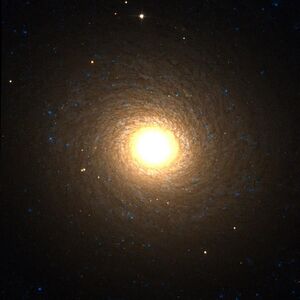Astronomy:NGC 7217
| NGC 7217 | |
|---|---|
 Spiral Galaxy NGC 7217 by HST, 1.62′ view | |
| Observation data (J2000 epoch) | |
| Constellation | Pegasus |
| Right ascension | 22h 07m 52.4s[1] |
| Declination | +31° 21′ 33″[1] |
| Redshift | 952 ± 2 km/s[1] |
| Distance | 50.0 Mly |
| Apparent magnitude (V) | 11.0[1] |
| Characteristics | |
| Type | (R)SA(r)ab[1] |
| Apparent size (V) | 3.9′ × 3.2′[1] |
| Other designations | |
| UGC 11914,[1] PGC 68096[1] | |
NGC 7217 is an unbarred spiral galaxy in the constellation Pegasus.
Features
NGC 7217 is a gas-poor system[2] whose main features are the presence of several rings of stars concentric to its nucleus: three main ones –the outermost one being of the most prominent and the one that features most of the gas and star formation of this galaxy –[2] plus several others inside the innermost one discovered with the help of the Hubble Space Telescope; a feature that suggests NGC 7217's central regions have suffered several starbursts.[3] There is also a very large and massive spheroid that extends beyond its disk.[4]
Other noteworthy features this galaxy has are the presence of a number of stars rotating in the opposite direction around the galaxy's center to most of them[5] and two distinct stellar populations: one of intermediate age on its innermost regions and a younger, metal-poor version on its outermost ones.[6]
It has been suggested these features were caused by a merger with another galaxy[7] and, in fact, computer simulations show that NGC 7217 could have been a large lenticular galaxy that merged with one or two smaller gas-rich ones of late Hubble type becoming the spiral galaxy we see today;[6] however right now this galaxy is isolated in space, with no nearby major companions.[6] More recent research, however, presents a somewhat different scenario in which NGC 7217's massive bulge and halo would have been formed in a merger and the disk formed later (and is still growing) either accreting gas from the intergalactic medium or smaller gas-rich galaxies, or most likely from a previously existing reserve.[8]
See also
- Spiral Galaxy NGC 1512
- NGC 7742, a very similar galaxy in the same constellation
References
- ↑ 1.0 1.1 1.2 1.3 1.4 1.5 1.6 1.7 "NASA/IPAC Extragalactic Database". Results for NGC 7217. http://nedwww.ipac.caltech.edu/.
- ↑ 2.0 2.1 Verdes-Montenegro, L.; Bosma, A. (1995). "The three rings of the isolated galaxy NGC 7217". Astronomy and Astrophysics 300: 65. Bibcode: 1995A&A...300...65V.
- ↑ Combes, F.; García-Burillo, S.; Boone, F.; Hunt, L.K. et al. (2004). "Molecular gas in NUclei of GAlaxies (NUGA). II. The ringed LINER NGC 7217". Astronomy and Astrophysics 414 (3): 857–872. doi:10.1051/0004-6361:20031664. Bibcode: 2004A&A...414..857C.
- ↑ Buta, R.; van Driel, W.; Braine, J.; Combes, F. et al. (1995). "NGC 7217: A Spheroid-dominated, Early-Type Resonance Ring Spiral Galaxy". The Astrophysical Journal 450: 593. doi:10.1086/176169. Bibcode: 1995ApJ...450..593B.
- ↑ Merrifield, M.R.; Kuijken, K. (1994). "Counterrotating stars in the disk of the SAB galaxy NGC 7217". Astrophysical Journal 432 (2): 575–589. doi:10.1086/174596. Bibcode: 1994ApJ...432..575M.
- ↑ 6.0 6.1 6.2 Sil'Chenko, O.K.; Chillingarian, I.V.; Sotnikova, N.Y.; Afanasiev, Victor L. (2011). "Large-scale nested stellar discs in NGC 7217". Monthly Notices of the Royal Astronomical Society 414 (4): 3645–3655. doi:10.1111/j.1365-2966.2011.18665.x. Bibcode: 2011MNRAS.414.3645S.
- ↑ Sil'Chenko, O.K.; Moiseev, A.V. (2006). "Nature of Nuclear Rings in Unbarred Galaxies: NGC 7742 and NGC 7217". The Astronomical Journal 131 (6): 1336–1346. doi:10.1086/499945. Bibcode: 2006AJ....131.1336S.
- ↑ Fabricius, M. H.; Coccato, Lodovico; Bender, R.; Drory, N.; Gössl, C.; Landriau, M.; Saglia, R. P.; Thomas, J. et al. (2009). "Regrowth of stellar discs in mature galaxies: the two-component nature of NGC 7217 revisited with VIRUS-W". Monthly Notices of the Royal Astronomical Society 441 (3): 2212–2229. doi:10.1093/mnras/stu694. Bibcode: 2014MNRAS.441.2212F.
External links
- NGC 7217
- http://atlas.zevallos.com.br/
- NGC 7217 on WikiSky: DSS2, SDSS, GALEX, IRAS, Hydrogen α, X-Ray, Astrophoto, Sky Map, Articles and images
Coordinates: ![]() 22h 07m 52.4s, +31° 21′ 33″
22h 07m 52.4s, +31° 21′ 33″
 |


